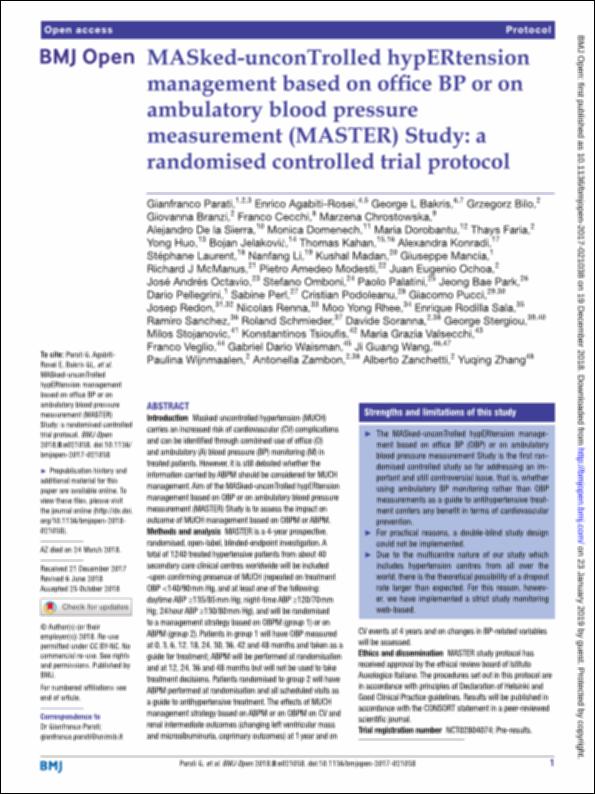Por favor, use este identificador para citar o enlazar este ítem:
http://hdl.handle.net/10637/10518MASked-unconTrolled hypERtension management based on office BP or on ambulatory blood pressure measurement (MASTER) study : a randomised controlled trial protocol
| Título : | MASked-unconTrolled hypERtension management based on office BP or on ambulatory blood pressure measurement (MASTER) study : a randomised controlled trial protocol |
| Autor : | Parati, Gianfranco Rodilla Sala, Enrique |
| Materias: | Hipertensión.; Enfermedades cardiovasculares - Pacientes - Factores de riesgo.; Blood pressure.; Cardiovascular system - Diseases - Patients - Risk factors.; Presión sanguínea.; Hypertension. |
| Editorial : | BMJ Open. |
| Citación : | Parati, G. et al. (2018). MASked-unconTrolled hypERtension management based on office BP or on ambulatory blood pressure measurement (MASTER) study : a randomised controlled trial protocol. BMJ Open, vol. 8, n. 12, e021038. DOI: http://dx.doi.org/10.1136/bmjopen-2017-021038 |
| Resumen : | Introduction. Masked uncontrolled hypertension (MUCH) carries an increased risk of cardiovascular (CV) complications and can be identified through combined use of office (O) and ambulatory (A) blood pressure (BP) monitoring (M) in treated patients. However, it is still debated whether the information carried by ABPM should be considered for MUCH management. Aim of the MASked-unconTrolled hypERtension management based on OBP or on ambulatory blood pressure measurement (MASTER) Study is to assess the impact on outcome of MUCH management based on OBPM or ABPM. Methods and analysis. MASTER is a 4-year prospective, randomised, open-label, blinded-endpoint investigation. A total of 1240 treated hypertensive patients from about 40 secondary care clinical centres worldwide will be included -upon confirming presence of MUCH (repeated on treatment OBP <140/90 mm Hg, and at least one of the following: daytime ABP ≥135/85 mm Hg; night-time ABP ≥120/70 mm Hg; 24 hour ABP ≥130/80 mm Hg), and will be randomised to a management strategy based on OBPM (group 1) or on ABPM (group 2). Patients in group 1 will have OBP measured at 0, 3, 6, 12, 18, 24, 30, 36, 42 and 48 months and taken as a guide for treatment; ABPM will be performed at randomisation and at 12, 24, 36 and 48 months but will not be used to take treatment decisions. Patients randomised to group 2 will have ABPM performed at randomisation and all scheduled visits as a guide to antihypertensive treatment. The effects of MUCH management strategy based on ABPM or on OBPM on CV and renal intermediate outcomes (changing left ventricular mass and microalbuminuria, coprimary outcomes) at 1 year and on CV events at 4 years and on changes in BP-related variables will be assessed. |
| Descripción : | Este artículo se encuentra disponible en la página web de la revista en la siguiente URL: https://bmjopen.bmj.com/content/8/12/e021038 |
| URI : | http://hdl.handle.net/10637/10518 |
| Derechos: | http://creativecommons.org/licenses/by-nc/4.0/deed.es |
| ISSN : | 2044-6055. |
| Fecha de publicación : | 19-dic-2018 |
| Centro : | Universidad Cardenal Herrera-CEU |
| Aparece en las colecciones: | Dpto. Medicina y Cirugía |
Los ítems de DSpace están protegidos por copyright, con todos los derechos reservados, a menos que se indique lo contrario.


